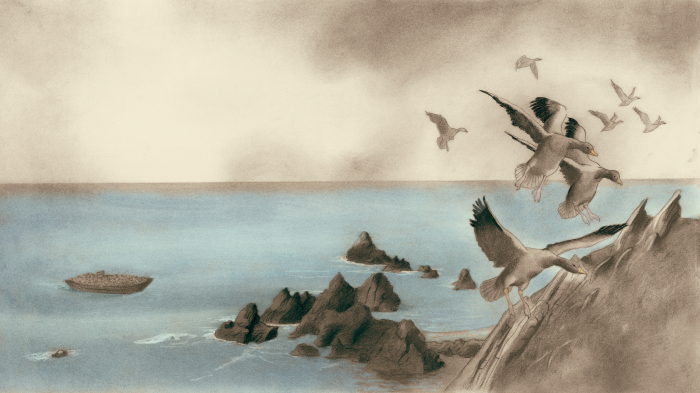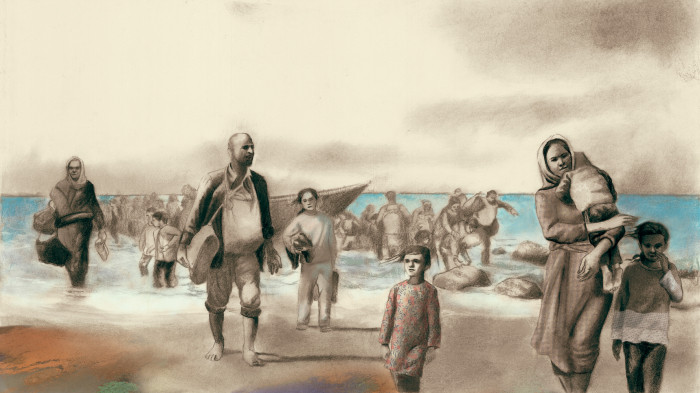Two journeys proceed in parallel and intertwine in the book Un viaggio diverso (A Different Journey), written by Daniel H. Chambers and illustrated by Federico Delicado: a goose and her gosling start their migratory route to the Southern regions, while a family living in a war zone moves northward. In a time marked by the tragedy of the refugees, this book is both appropriate and necessary, sensitive and delicate, able to arise a deep thought and a feeling of hope and solidarity towards those millions of people who have the right to live in peace and freedom. We have interviewed the authors to discover the background of their work. “The story started swirling in my head during the war in the Middle East. Since the beginning I’ve been thinking it would be better to associate words and images” says author Daniel H. Chambers. “I tried to keep the text to a minimum, confined only to what was necessary. While doing it, I realised that the story was offering me new ideas and new characters, but I endeavoured to keep under control the temptation to follow them. Then, when Federico ended his work, we realised that it was important to further reduce the text, in order to avoid repetitions.” Kalandraka asked Federico Delicado to interpret a story stripped-down by its author, writer of 18 novels published in Spain and South America. And he was assailed by the same doubt: “Try to imagine an illustrator escaping from death in Syria or any other place. Let’s imagine him armed with only a piece of charcoal and some cardboard he finds along the way. Armed with a simple charcoal to defeat death or at least to leave some traces of this experience”. The illustrator – who won the Compostela Prize in 2014 and has published more than 30 works from the 1970s – has chosen to strip-down his sign as well in order to emphasise the topic of the humanitarian emergency. “I wanted reality to take possession of the drawing so that the drawing could at least empathise with it. I had to step aside and leave the language free, with its burden of truth, without any prevailing voice”. Largely satisfied with the final result, Chambers admits: “While I was writing, I tried to imagine the kind of images that would possibly match the text, anyway also my imagination failed to produce something as brilliant as Federico’s work. I am really grateful to the publishers for choosing him as illustrator”. In his first sketches, Federico Delicado focused on migrations from sub-Saharan countries: “A chaos of domestic animals and people against an ochre background, made of dust and columns of black smoke to evoke war. I got carried away by the beauty of bodies and figures that African art so exquisitely shows in its prehistoric as well as contemporary expressions. But, shortly afterwards, the news from Syria came and flooded the European media like an unstoppable rain. I was sorrowful and had doubts: did I chose Africa just for aesthetical and cultural reasons? So I went back to work, considering the Middle East, and I decided to think about this work from the perspective of a graphic reporter”. Chambers puts the reader in the middle of the season preceding the migration of the geese, and in so doing resorts to literary storytelling in order to think about population displacements during the XXI century, paying special attention to the Mediterranean area. “The reasons behind migrations today are the same that induced our parents and grandparents to leave their mother countries: improving their economic status and fleeing from war. I never believed in the notion of border, let alone the idea that some people are less important than others only because they come from different geographical areas.” The focus on the geese offered Delicado the opportunity to tackle another kind of plundering: “The human beings, in an imaginary river landscape, sacrifice nature to make room for industrial work”. A basic range of colours and a mainly descriptive approach are the main features of Delicado’s style in this book. The way faces are represented makes the characters seem to constantly look for the reader’s eyes. On the other hand, the author seems reluctant to show the sufferings of this mankind. Naturalism and symbolism weave together in images that have a significantly evocative impact. “When an author chooses to tell a true story, he finds himself lying with Reality. The only solution is fictional creation”. Federico Delicado considers himself a craftsman, “a man who believed in the tale of the artist dominating language and creativity, but that in the end finds himself dominated by his art. A man who starts disappearing along the way to make room for the expression of a widespread feeling”.
UN VIAGGIO DIVERSO
by Daniel H. Chambers and Federico Delicado
Kalandraka

